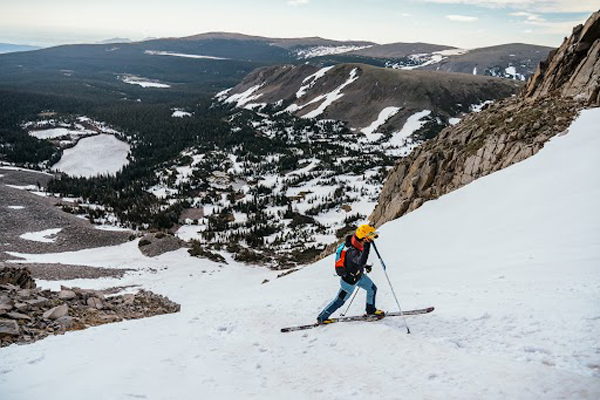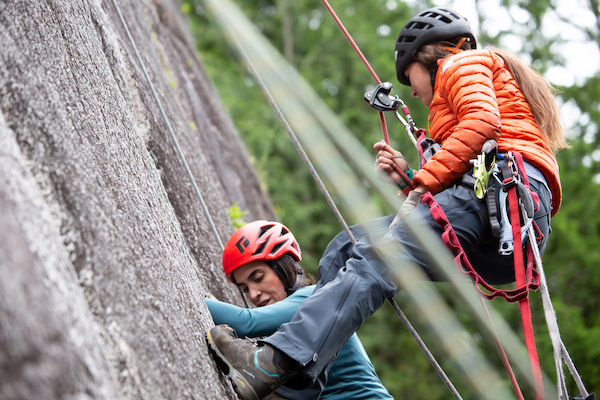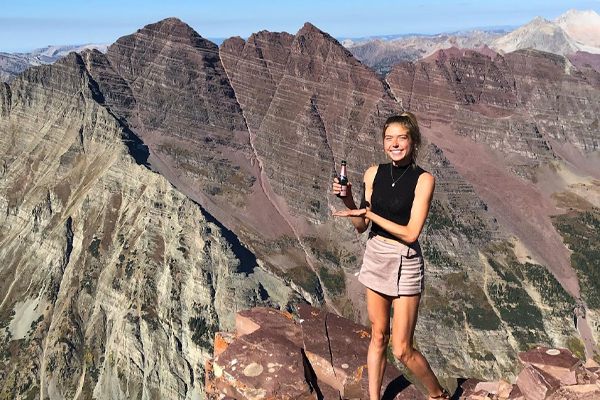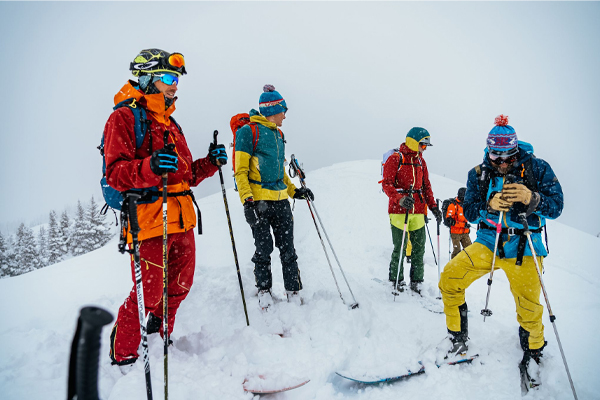Fitz Roy Patagonia - Gisely Ferraz

On top of Fitz Roy in Patagonia —and at the top of my dreams— at the summit, I spread his ashes.
After a tragic accident, how do you find a reason to keep going?
In 2019, I lost the love of my life in a climbing accident on the Chief, in Squamish, British Columbia. He was climbing an easy pitch, a pitch he had climbed so many times before. But, like life, rock is not infinite. A hold broke, and I watched him fall and land violently on a ledge 80’ below. I down climb to him, and held him in my arms for three hours until Search and Rescue showed up. Ken passed away in my arms. I was devastated. I couldn’t believe what had just happened. My pain was impossible to handle, I just couldn’t see myself living on this earth anymore. However, amidst all of this pain, I found light in the people around me—or, rather, their light found me. My community never left me alone. I received a massive outpouring of support. Text messages and phone calls and invitations to climb…
Eventually, I realized that sitting in the stillness of pain would only make it harder for me—and for Ken’s friends and family—to process and come to peace with the tragedy. Ken was such an amazing human. His story couldn’t be any more tragic. I needed to do something amazing in his honor, so I took all of the pain I felt and transformed it into power. I was determined to accomplish all of the dreams I shared with Ken. I made a promise that I would never give up on life, and that I would spread his ashes on the summits he always dreamed of reaching.
For two years, I climbed peak after peak to spread Ken’s ashes: The Hulk, El Captain, Half Dome, and, finally, I found myself booking a ticket to Patagonia. Patagonia is famous for its bad weather and long approaches, it’s dangerous but spectacular...
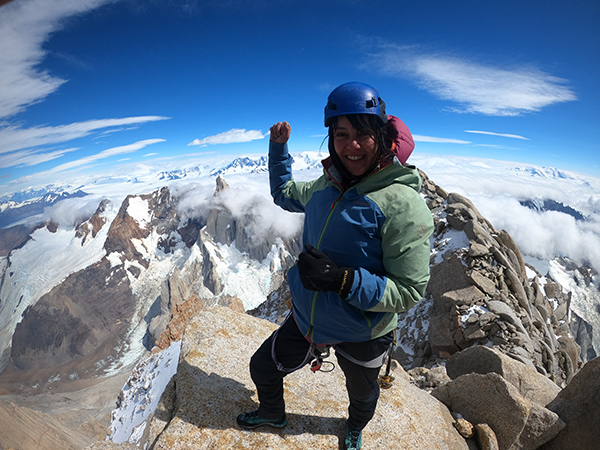
Seeing the Fitz from Laguna Sucia for the first time brought tears to my eyes. It’s just so beautiful, so big, so far away, and such adventurous climbing. I felt more connected with Ken on big adventure-type climbs than anywhere else. Missing Ken forced me to live in the present, blunt my sharpness, release my worries, and calculate each step I needed to take towards our dreams. The pain of losing him gave me focus and strength. I would use that focus and strength to reach the summit of Fitz Roy, which was one of Ken’s greatest dreams.
El Chaltén is a friendly town. People have a very welcoming culture—all together, we celebrated life and death. I arrived immediately following an accident on Cerro Torre. The whole community of alpinists was looking for Korra Pesce’s body. A fellow La Sportiva athlete, Korra had just established a new line to the summit of Cerro Torre but was caught in an avalanche on the descent. The weather window in Patagonia is often small, and the mountains can become consumed with clouds and bad weather in the blink of an eye. No one dared to be in those mountains with the bad weather, and it was not possible to recover his body.
After a week of exploring El Chaltén, I contracted COVID. I spent 10-days quarantined in a tent, trying to recover from the virus. The mountains were a temple of appreciation, and I spent my quarantine admiring them, asking them for permission to climb them.
On day 12, a good weather window was confirmed. I was finally feeling better (plus, I had spent too much time alone). I talked to every possible climbing partner I could find. The whole town was in motion, with climbers feverishly buying food and packing their gear. Just in time to take advantage of the weather window, Pedro Cifuentes of Spain and a local climber named Franco invited me to climb Fitz Roy via the Afanassieff route.
To climb Fitz Roy you need to be prepared for just about everything…and then some. Anything can happen in the mountains, including everything you don’t know. Each member of our team brought a different set of skills to the table. I lacked experience in glacier travel and rappelling in Patagonia, but I could be the main leader on the hard pitches. My team had the experience that I did not.
I wasn’t sure If I could handle the approach, but I was damn sure I could climb the mass of Fitz Roy. On the 8-hour-long approach to Paso del Cuadrado, I told my partners that my main goal was spread Ken’s ashes on the summit. The act of verbalizing my goal gave me strength when I was tired. It helped me stay laser-focused on the glaciers. I imagined the word “power” on every single step, for hours of travel on loose rock and up huge hills and across glaciers and back down hills. My goal became a mission for my team. It had really intense meaning. They got it.
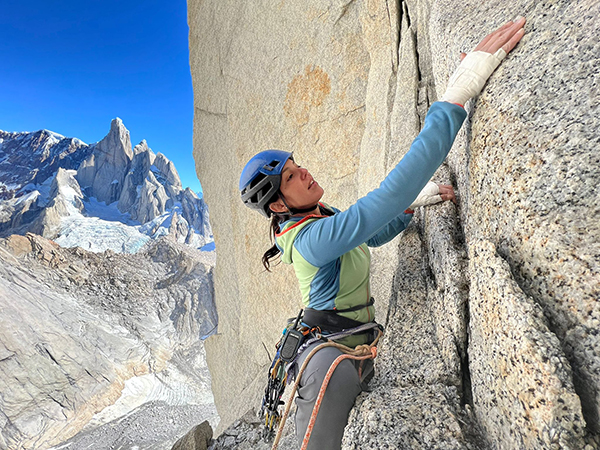
Standing beneath Fitz Roy was overwhelming, but after breaking the climb down into parts, it felt more manageable. I had practiced this strategy with other big climbs I had done in the past. I felt myself in my element. The challenge of climbing Fitz Roy matched my skills, and I was confident about leading most of the rock pitches. Pedro would lead the technical ice and loose rock pitches, and Franco would carry more weight so the leader could have a lighter backpack. Climbing with a heavy backpack is hard, so you have to be really comfortable at that grade, and with that level of exposure.
When I finally touched the crispy alpine granite, I couldn’t believe I was climbing Fitz Roy. Jamming splitter cracks on a beautiful, sunny day in the Patagonian mountains. I was comfortable on the Afanassief route and stoked to climb 1,550 meters of pure alpine granite. The mountains around us played a symphony of rockfall and avalanches, all part of the experience of being in the mountains. The mountains were in movement, but so was I. I was starkly aware of the danger all around us, and the importance of moving quickly, steadily, and safely…
My partners stayed positive and kept the stoke high: giving up and rappelling the route would require us to leave a lot of gear behind, as there are no anchors…just some old slings here and there, remnants of climbers past. Just as there are no anchors, there is no real “route.” The top is a mere suggestion. It is up to the leader to determine the best way up. When I felt tired, I would turn around and let the stunning view reinvigorate me. Halfway up, we helped a party whose leader was injured in a fall. We helped with first aid, and they continued to climb up behind us. Now there were three of us, plus two others tagging along.
The climbing was stellar and so much fun. We reached the summit on the morning of our third day, embracing the emotional moment of setting foot on top of this mountain, which had been a dream for both Ken and me. I could see Ken’s smile. I could feel his presence and his protection. All five of us celebrated at the summit, taking photos and breaking into tears.
I couldn’t believe I was able to release Ken’s ashes on the summit of Fitz Roy during my first season in Patagonia. It had been a long-term dream of mine. Now, it was my reality. Ken’s ashes disappeared into the air, while I held some tight, close to my heart. Losing him was the most devastating experience of my life. I lost the sense of joy and meaning in life for over a year after the accident.
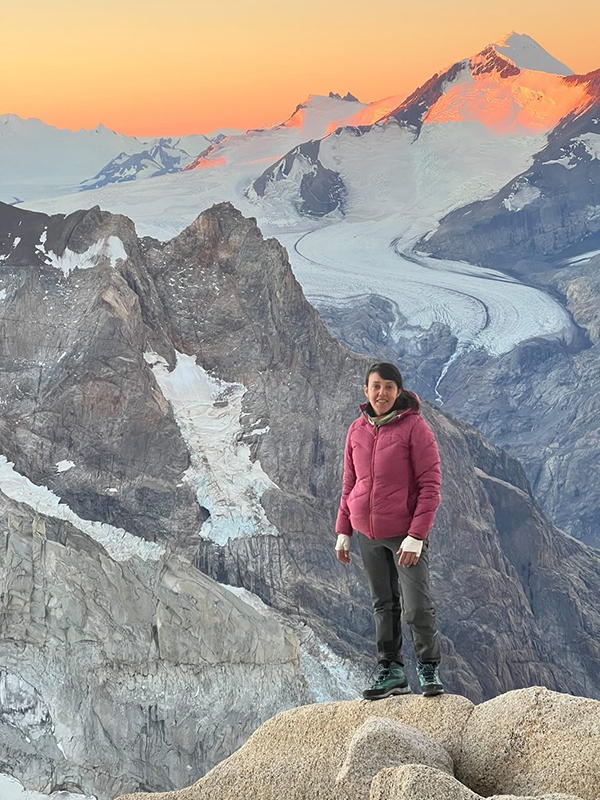
- - - -
Grief is deep and painful, but also powerful.
I was elated to be on the summit of Fitz Roy with Ken, feeling the pain of loss give way to the power of perseverance, strength, determination, and—above all—love. It took me two years of dedicated training to make this impossible dream come true, climbing in Yosemite, the desert of Utah, and so many other places to hone my skills and sharpness.
- - -
Back to reality, though, we were only halfway done with our climb of Fitz Roy. We had all heard nightmare stories of rappels gone wrong in Patagonia. That is the most dangerous part of the climb, after all. For us, it was no different.
First, we got lost finding the rappel line. From a beautiful sunny-day summit, we go caught in a cloud that came in so fast, we didn’t even notice. We did a few rappels to end up at the Super Canaleta. Fortunately, we had a radio and were able to get in touch with some friends for more information. They told us to summit Fitz Roy again and to be careful, as two accidents had already happened on the rappel side, leaving one alpinist dead.
The conditions changed incredibly fast. What had been a beautiful, sunny day, turned to wind, light snow, and horrible visibility. We started to climb Fitz Roy again, but this time on ice and snowy terrain. The wind was so strong, that I expected it to blow me off the wall at any minute. It was blowing so hard that the snow hurt my face and eyes, each flake a little dagger. We realized that our mission had turned serious.
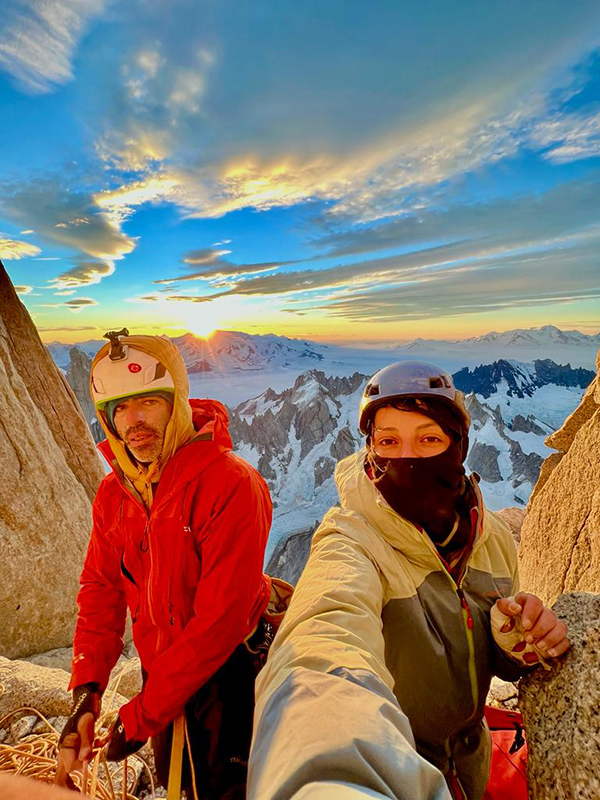
I forced myself to stay focused, to avoid looking over the edge where fear and death were laying. I concentrated on my technique, I asked Ken for protection and remembered how I promised my son I would come home alive.
Hours later we summited Fitz Roy again, in extremely adverse conditions. We enclosed ourselves under a tarp, and, again, radioed to our friends in town. We checked the weather, the bad storm wasn’t coming for another 30 hours or so…but we were inside of a cloud with close to no visibility. Cloud or not, our friends made one thing clear: you must come down now.
We were all tired, but my partners never let the stress of the situation take over. I had to keep my mind strong, but I knew that—with these conditions—we were very close to pushing past the limit. We ate some food to recover some energy, as we were all shaking from the cold. I was so grateful to be wearing exceptional, technical clothing, boots, and gloves. The gates on my carabiners started to freeze, and I had a hard time opening them. It was the coldest I had ever been in my life. But my mind started to drift towards the sunny day on the Chief, when I lost Ken. I had been through worse times. Being there, freezing, was ok. I dug deep and drew upon my strength.
We left the freezing, snowing bivy at 10 pm, and it took us 20 minutes to find the rappel line, which was covered with a new layer of snow. The rappels in Patagonia are more often than not built on the scariest anchors: old slings, ancient cordelettes, rusty pitons, and questionable nuts. We rappelled three pitches and saw the town. The moon was rising, and we were no longer shrouded in the thickness of a cloud. I knew we would survive if we could continue rappelling through the night, but if we stayed up there, we would probably freeze to death. It was a long and cold night rappelling, we never took our crampons off.
We got a call from our friends telling us they would come to meet us at the glacier, but we told them we didn’t need a rescue. We were slow, but we were going to be okay. They insisted on coming, as “Brecha de Los Italianos,”—the last rappel after the “La Silla,” where the accidents had happened the day before —was critical.
It is a dead-loose gully. This season, the rappel was more dangerous than usual, because the glacier has been melting faster. Our friends wanted to be there waiting for us, in case of another rock fall. They would be ready to help us in the case of an emergency.
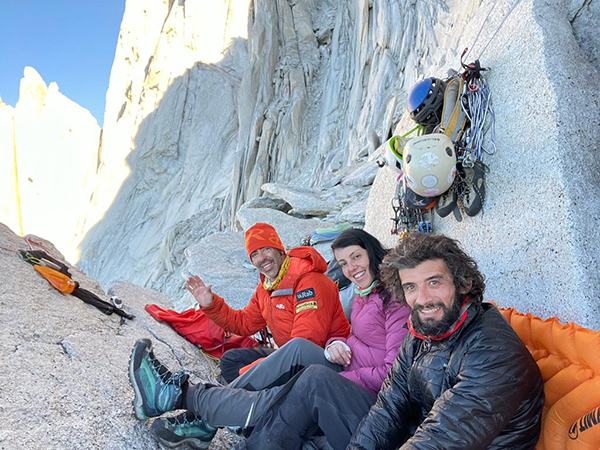
The rappel was highly technical. It was a traverse to the left the whole time. It was airy, and we were exhausted and dehydrated, as our water had frozen. Finally, we reached the “La Silla.” Two dead bodies were buried here: we could see a foot, and crampon buried in the snow, and another under a pile of rocks. We knew John Bolte, an American climber was lying dead somewhere under this rappel—he died instantly after being caught in rockfall the day before. We could smell death. We knew that the next 6 rappels would be the most dangerous ones, and we concentrated on developing and following a good strategy.
Our plan was one by one, to rappel the gully. Only after the previous climber reached the glacier below would the next start rappelling. It was slow but much safer. I had to prepare myself, as the gully was loose and dark, and the smell of death infiltrated the air. All of the ropes were fixed at this point, because the day before, a volunteer rescue team had gone up to rescue a Colombian alpinist whose leg had been hit by a rock.
I kept rappelling, and I kept passing blood marks on the wall. It was night, though, so I could choose what I wanted to see. On the last rappel, some rocks started to fall, and I ducked under a little roof. I immediately knew I was taking cover where John’s body was—the blood stain was impressive. I focused on being efficient and told myself I was going to rappel as fast I could. I decided not to look around, that I didn’t want to see him, that I didn’t want to let my feelings take precedent over my skills.
Finally, I reach the glacier, happy to be safe, but very aware that my friends still needed to rappel. I was the first one down. I walked on the glacier for about 30 minutes, until I could see the light from our friend’s tent, waiting for us in the darkness. They were there, prepared for a possible rescue, ready with warm food and tea. Soon after I arrived, they fed me and asked about the others. I was safe in a tent with people I didn’t know. They told me that, after all the many recent tragedies, the whole town had been watching us rappel through the night. They were worried about what might happen in the “Brecha,” the gully that had taken so many climbers’ lives.
Hours later, we had all made it down safely. After the “Paso Superior,” another group of alpinists were waiting for us with more food and tea. It was beautiful to see the whole community leave their safe and warm homes to come to help us.
Finally, warm and safe, I just needed to hike about seven more hours to get to El Chaltén. I was on safe ground, finally…but hours away from town. More climbers came to meet us, with more food! Slowly, as the terrain got easier, they started to hike faster, and I stayed behind.
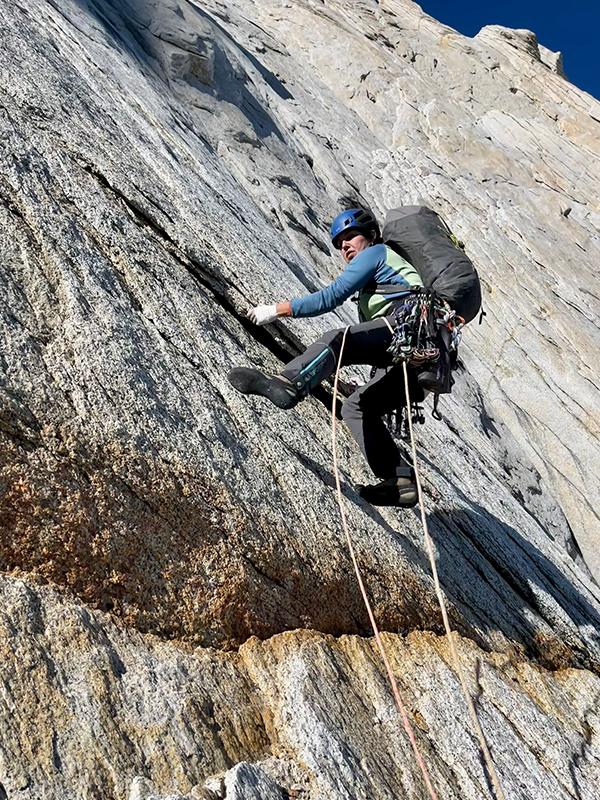
My team waited for me at the Laguna de Los Tres. We were on top of the world about our achievement, though our happiness was marred by a feeling of sadness for those who didn’t make it back. I was impressed with the volunteers of “Commission de Auxilio of Chalten,” for their excellent teamwork in executing a rescue the day before, and coming back for us, to make sure we made it down safely.
As humans, we never learn how to deal with death, but we learn how to care about others. As we get older, we lose more and more people. During both of the most extreme moments of my life, I was supported by my climbing community. People who I didn’t even know reached out to me after Ken’s accident, and now I have seen firsthand how the mountains give…and take. Fitz Roy was the most beautiful experience of my life. I learned to be there for others, to love, to help, to go after my dreams, and that living in fear is often just as dangerous as taking risks.
Life experiences don’t always shape us in comfortable ways, but they always shape us into better versions of ourselves. Growing through pain builds the type of strength that can overcome any adversity. It empowers us to take on future challenges, and realize incredible experiences.
I’m happy to have achieved this dream.
I’m thankful for my climbing community.
But, above all, I am honored to have spread Ken’s ashes where he wanted to be: in the mountains, above all odds.

